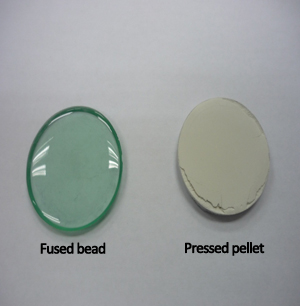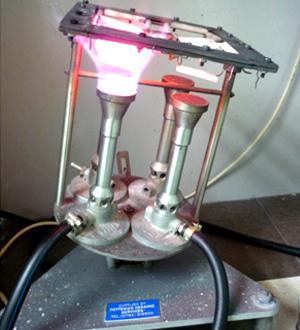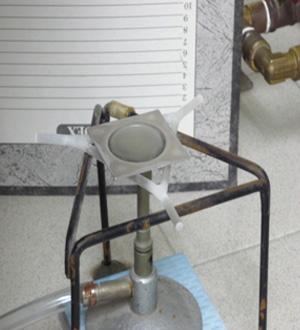Chemical Analysis by X-Ray Fluorescence (XRF) is conducted for a wide range of purposes for material identification and characterization to quality control monitoring. The types of materials that can be analysed by XRF include ceramic products (for eg tiles, pottery, tableware, sanitaryware), raw materials (for eg clay, sand feldspar, limestone), refractories, glass , etc.
For most ceramic materials, chemical analysis involves the determination of SiO2, Al2O3, Fe2O3, TiO2, MgO, Na2O, K2O, CaO together with loss on ignition at about 1000°C due to loss of combined water, decompostion of eg. Carbonates etc. The basic principle of XRF involves irradiating a sample with incident X-rays and measuring the secondary X-rays emitted. These secondary X-rays which are characteristic of each element in the sample are detected and measured to give a full analysis of the sample.
XRF is a method for measuring elemental contents of raw materials and body formulations but not for identifying the mineralogy. There are 2 sample preparation techniques namely pressed pellet and fused bead:-
a) For the pressed pellet method, samples are grinded into powder form and pressed into discs
b) For the fused bead method, a fused bead of about 40mm diameter is obtained by fusing the sample in a platinum dish using lithium borate as a flux.

The pressed pellet method is more suitable for samples with a particular similar mineralogy composition such as limestone, cement etc. The pressed pellet samples may have identical chemical composition but may differ in terms of mineralogical make-up and particle size. These differences can lead to differences in elemental count-rates and thus lead to inaccurate results. By grinding the samples, the particle size effects may be eliminated to a certain extent. However, contamination increases with reduced particle size and an increase in surface area. Calibration problems may occur as accurate results can only be obtained if the mineralogical composition is identical to the standards used for calibration. In some instances differences in mineralogy may occur in the same clay quarry and the calibration for the particular clay sample would be deemed invalid. Separate calibrations are required for every particular type or source of sample and maintaining the numerous calibrations is a very tedious process. Preparing the samples using the pressed pellet method is convenient and relatively easy but would not be suitable if a wide range of samples are to be analysed.
The fused bead method is carried out by first weighing the ignited sample with a flux such as lithium borate into a platinum dish and subjecting the mixture to high temperatures. The fusion melt is then casted into a casting mould and cooled. The procedure for preparing the fused bead is as below:-
 STEP 1
STEP 1Fusing of the sample and flux with the use of the fusion swirler
 STEP 2
STEP 2Casting of the melt into the casting mould
 STEP 3
STEP 3Cooling the fused bead on an air jet
The fused bead method has many advantages although it is quite a time-consuming process. The effective particle size of the sample is almost atomic. Both particle size and mineralogy effects are eliminated. Therefore, the samples have the same basic matrix. Primary calibration can be carried out with the use of pure oxides instead of analysed certified reference materials. Standards are prepared from primary oxides at uniformed intervals throughout a required range. This particular type of calibration is much more accurate and provides reliable test results for a wide variety of samples.
There are basically two types of X-Ray Fluorescence spectrometers namely the sequential spectrometer and simultaneous spectrometer. Simultaneous spectrometers are easier to operate as each channel has its own separate crystal, collimator and detector. The range of elements that can be analysed is however limited by the number of pre-determined fixed channels. The equipment may only be able to accommodate about 8-9 fixed channels and therefore certain elements such as Si, Al, Na, K, Fe, Ti, Ca and Mg can only be analysed and this is done simultaneously. As for the sequential spectrometer, the equipment which is relatively much costlier is able to analyse a very wide range of elements. However, the time needed for the analysis is much longer. The detector is placed at a fixed position and the crystal is rotated so that different wavelengths are detected by the detector one element at a time in sequence.
X-Ray Fluorescence spectrometers operate on either the wavelength dispersive or energy dispersive system. The wavelength dispersive system physically separates the X-Rays according to their wavelengths. The higher resolution of the wavelength dispersive system allows more complex samples to be accurately analysed quantitatively with improved detection limits and sensitivity compared to the energy dispersive system. The principle of the energy dispersive system is to directly measure the different energies of the emitted X-Rays and produce an XRF spectrum. The chemical analysis of the elements obtained by energy dispersive is semi-quantitative.
The table below shows examples of typical chemical analysis results for sodium feldspar and kaolin clay by X-Ray Fluorescence.
| Chemical analysis (%) | Sodium Feldspar | Kaolin Clay |
| Silica as SiO2 | 74.3 | 46.1 |
| Aluminium as Al2O3 | 15.4 | 34.8 |
| Titanium as TiO2 | 0.3 | 0.7 |
| Iron as Fe2O3 | 0.3 | 1.2 |
| Sodium as Na2O | 7.0 | < 0.1 |
| Potassium as K2O | 0.6 | 1.8 |
| Calcium as CaO | 1.4 | 0.1 |
| Magnesium as MgO | 0.3 | 0.4 |
| Loss on Ignition at 1025°C | 0.5 | 14.1 |
From the kaolin clay analysis, the Al2O3 element serves as an indicator for the amount of kaolinitic content in a clay sample. A pure kaolin has a theoretical value of 39.5% Al2O3. The alkaline content such as sodium (Na2O) and potassium (K2O) acts as the fluxing 'agent' in a raw material be it a clay or particularly for feldspar.Fluxes reduce the firing temperature of a ceramic product.The fired colour depends on the impurities in the sample which are mainly minerals containing Fe and Ti. The samples become darker with increasing amounts of Fe and Ti.